全文HTML
--> --> -->在理论方面, H + HBr反应的势能面构建也在最近的几十年中有了极大的进展. 基于多参考组态相互作用方法(MRCI)计算的104个从头算能量点, Lynch等[11]构建了第一个extended London-Eyring-Polanyi-Sato (eLEPS)函数形式的从头算势能面. 然而基于该势能面得到的速率常数往往低于实验值并且100多个能量点也不足以描述复杂的势能面地貌. 2003年, Kurosaki和Tayanagi[12]采用MRCI方法和AVTZ基组构建了BrH2体系基态和两个激发态的势能面, 并且在基态的势能面上考虑了自旋轨道耦合修正(MB1). 然而基于MB1势能面的速率常数明显大于实验值. 不久之后, 他们又对MB1势能面进行了修正, 降低了约0.3 kcal/mol的势垒高度, 并将新的势能面命名为MB2[13]. 之后又在MB2势能面的基础上修改了Br + H2渐进区T型结构的势阱, 并命名为MB3. Kurosaki和Tayanagi[12]的势能面得到了广泛的应用. Quan等[14-16]采用MB1, MB2和MB3势能面和含时量子波包方法进行了一系列的动力学计算并报道了反应概率、积分截面和速率常数等物理量. 结果表明对于H + HBr反应, MB3势能面明显优于MB1和MB2势能面, 基于MB3势能面的速率常数和实验结果十分吻合. Fu和Zhang[17]和Fu等[18]也采用MB3势能面和含时量子波包方法进行了动力学计算, 并报道了量子态分辨的积分和微分截面. 然而, Fu和Zhang[17]基于MB3势能面得到的速率常数明显大于实验值. 这与Quan等[14-16]得到的结果有很大的差异.
2011年, Jiang等[19]构建了H + HBr反应的一个新的势能面. 采用MRCI方法进行了从头算计算, 在计算中考虑了自旋轨道耦合修正并把基组外推到了完全基组极限. 此外, 基于新构建的势能面, Jiang等[19]采用含时量子波包方法进行了动力学计算. 结果表明基于该势能面得到的速率常数与实验结果十分吻合. 之后, Xie等[20]采用该势能面进行了H + HBr反应的态-态动力学计算, 报道了反应概率、积分截面、微分截面、产物的振动和转动态分布等动力学信息, 并与相应的实验结果进行了对比. 结果表明, 基于该势能面得到的产物振动和转动态分布与实验值存在较大差距. 同年, Jiang等[21]又构建了关于BrH2体系的透热势能面并计算了Br(2p3/2, 2p1/2) + H2反应的积分截面. 2012年, Xie等[22]采用Jiang等[21]构建的透热势能面在量子态分辨的理论水平上计算了Br(2p1/2) + H2反应的猝灭过程. 2012年Zhang等[23]也构建了BrH2体系的透热势能面并与Jiang等[21]的透热势能面进行了比较, 同时对D + DBr反应进行了动力学计算, 报道了积分截面和速率常数等动力学信息. 2014年, Zhang等[24]采用他们构建的透热势能面进行了H + HBr反应体系的同位素计算. 将得到速率常数与实验结果进行了对比, 发现理论结果与实验结果有或高或低的偏差. 最近的势能面是由Li等[25]在2019年构建的, 在从头算计算中采用MRCI方法、AVTZ和AVQZ基组计算了约63000个从头算能量点, 并采用神经网络方法对势能面进行了拟合. 势能面的构建过程中, 考虑了自旋轨道耦合修正并将基组外推到了完全基组极限. 此外, 基于新构建的势能面, Li等[25]采用含时量子波包方法进行了H + HBr反应的动力学计算. 得到的抽取通道的产物振转态分布以及速率常数都与实验结果十分符合.
综上, 之前的理论研究大部分集中在H + HBr反应上, 对于同位素的理论研究相对较少. 据我们所知, 到目前为止还没有关于其同位素反应在量子态分辨理论层次上的研究. 基于Li等的势能面, 本文采用含时量子波包法和二阶分裂算符传播子对D + DBr反应进行初态为(v0 = 0, j0 = 0)的动力学计算.


在进行动力学计算之前, 具有确定初始振动和转动量子态的初始波包需要提前构建. 初始的含时波包是由体坐标系下的平动、振动和转动基矢构成



在传播过程中, 二阶分裂算符[31]进行初始波包的传播. 假设t时刻的波函数为






在计算中, 采用快速傅里叶变换[32]计算径向动能算符, 在离散变量表象[33]里计算势能算符. 此外, 为了满足边界条件, 在边界处设置一个吸收势, 其形式为





指定初始量子态的速率常数是通过热平均积分截面的平动能得到, 其公式为

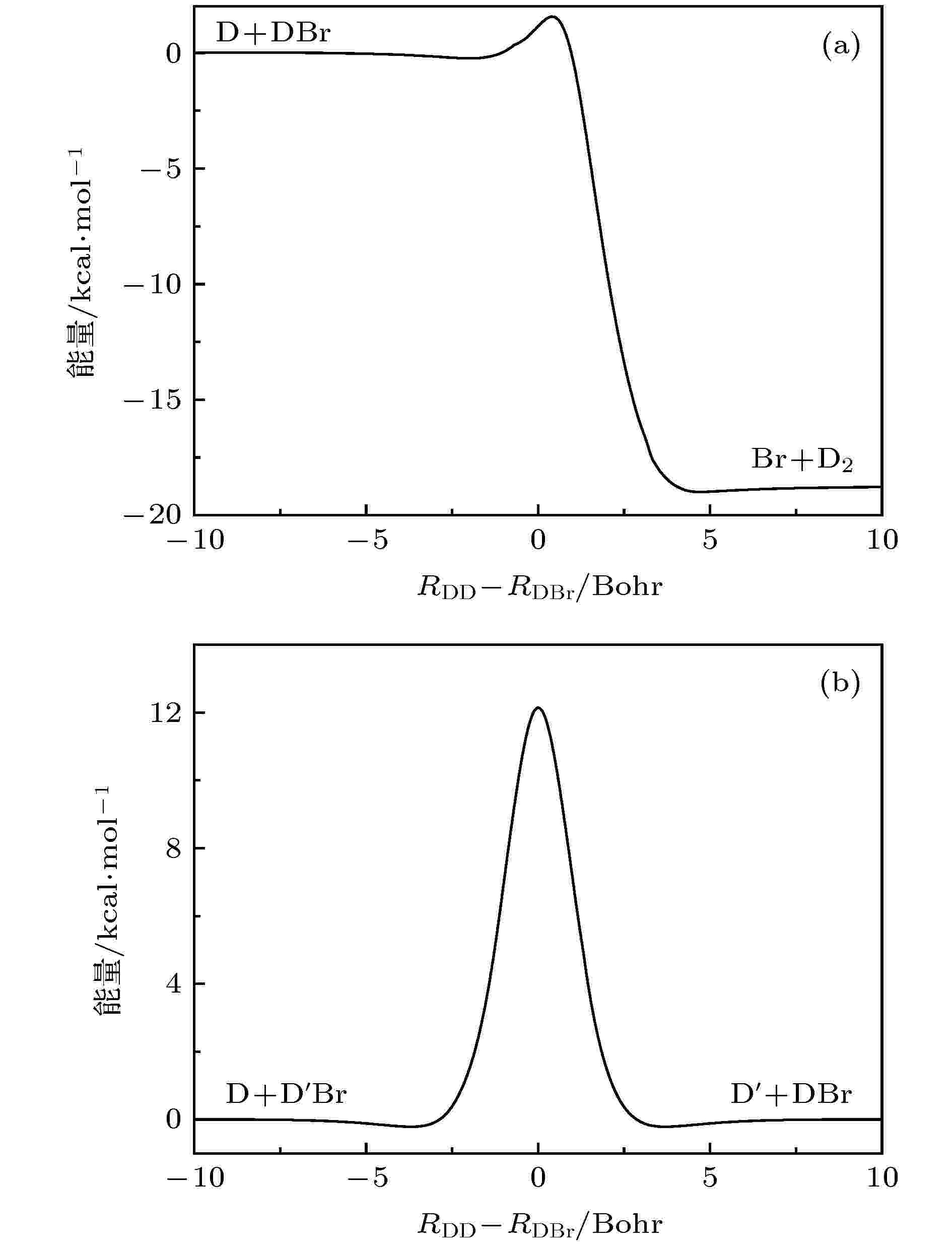 图 1 势能面的最小能量路径 (a) 抽取反应通道; (b) 置换反应通道
图 1 势能面的最小能量路径 (a) 抽取反应通道; (b) 置换反应通道Figure1. Minimum energy path of the potential energy surface: (a) Abstraction channel; (b) exchange channel.
在进行动力学计算之前需要对计算参数进行调试. 本文测试了不同参数J = 0的反应概率, 并最终得到了最优的收敛参数. 计算中使用的参数如下:
格点范围和大小







初始波包






投影截面位置

总角动量J在z轴投影数目

总的传播时间

传播时间步长

2
3.1.反应概率
在0—2.0 eV的碰撞能范围内, 总角动量J = 0, 20, 40, 60, 80, 90的反应概率见图2. 通过Li等[25]的势能面可知, 对于抽取反应和置换反应对应的势垒高度分别为1.54 kcal/mol (约0.067 eV)和12.14 kcal/mol (约0.525 eV). 由图2可知, 对于抽取反应, 其阈值接近为0; 对于置换反应, 其阈值约为0.47 eV; 明显低于势能面上的势垒高度, 这是由于无论是抽取反应还是置换反应都发生了隧穿效应, 从而降低了反应阈值. 对于抽取反应, 所有J的反应概率的外形都很类似. 都是先快速升高当峰值接近0.1左右之后随着碰撞能的升高反应概率降低. 这是因为当能量较低的时候只能通过隧穿效应发生反应, 随着能量升高, 隧穿效率增加反应概率增高. 而当碰撞能大于势垒高度, 巨大的放热能使得D原子的速度变快, DBr分子来不及与D原子形成化学键. 因此, 当碰撞能升高时, 反应概率反而降低, 这也是放热反应的典型特征. 对于置换反应, 反应概率随着碰撞能的升高而增高, 计算的最大J = 90, 由图2可知, 在研究的碰撞能范围内所有的结果都是收敛的. 然而, 对于抽取反应只有在碰撞能低于1.2 eV时, 得到积分截面和微分截面的结果才是收敛的.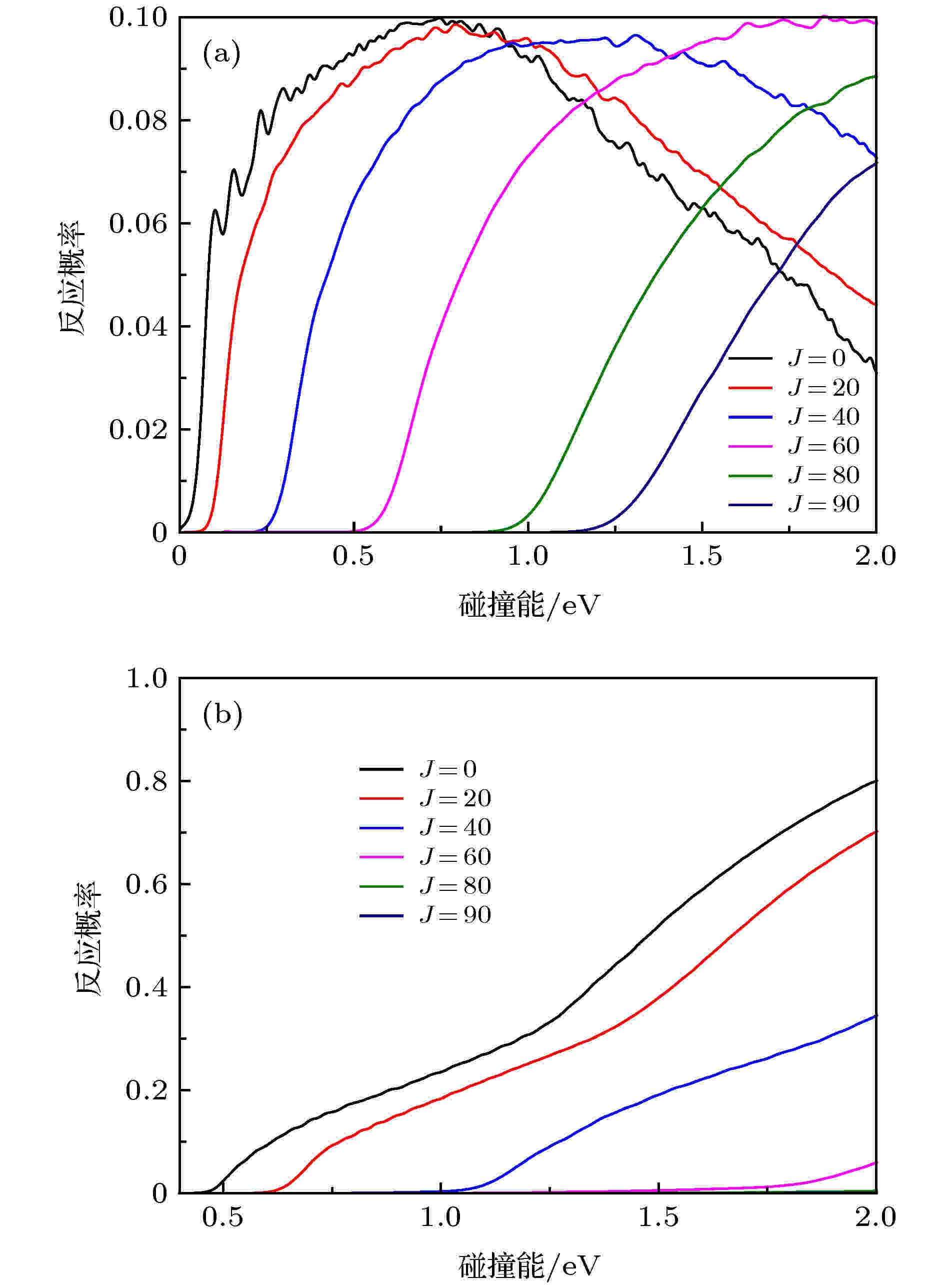 图 2 若干总角动量J的反应概率 (a) 抽取反应; (b) 置换反应
图 2 若干总角动量J的反应概率 (a) 抽取反应; (b) 置换反应Figure2. The reaction probabilities of several selected total angular momentum J: (a) Abstraction reaction; (b) exchange reaction.
2
3.2.积分截面
抽取反应的总积分截面和振动态分辨的积分截面分别列入图3(a)和图3(b). 为了与其他理论结果比较, Zhang等[24]的结果也列入到了图3(a). 如图3(a)所示, 本文的结果与Zhang等[24]的结果十分符合尤其是当碰撞能比较低的时候, 然而随着碰撞能的增加, 本文的结果与Zhang等[24]的结果差距逐渐变大. 这可能是由于计算中使用了不同的势能面. 本文采用的是2019年Li等[25]最新报道的绝热势能面, 该势能面没有考虑不同电子态之间的非绝热效应. 而Zhang等[24]结果是基于他们自己构建的非绝热势能面. 我们认为高能部分的差距是由于非绝热效应引起的. 图3(b)列入了积分截面的振动分辨, 发现了一个有趣的现象, 当碰撞能低于0.45 eV时, 出现了振动粒子数反转的现象. 产物D2的分布主要集中在v' = 1上. 随着碰撞能的升高, 反转现象变得不明显进而消失. 这种反转分布符合Polanyi的规则[36,37]. 随着碰撞能的升高, 其他振动激发态的通道逐渐打开. 尽管如此, D2分子的振动态分布主要还是集中在基态和第一激发态上.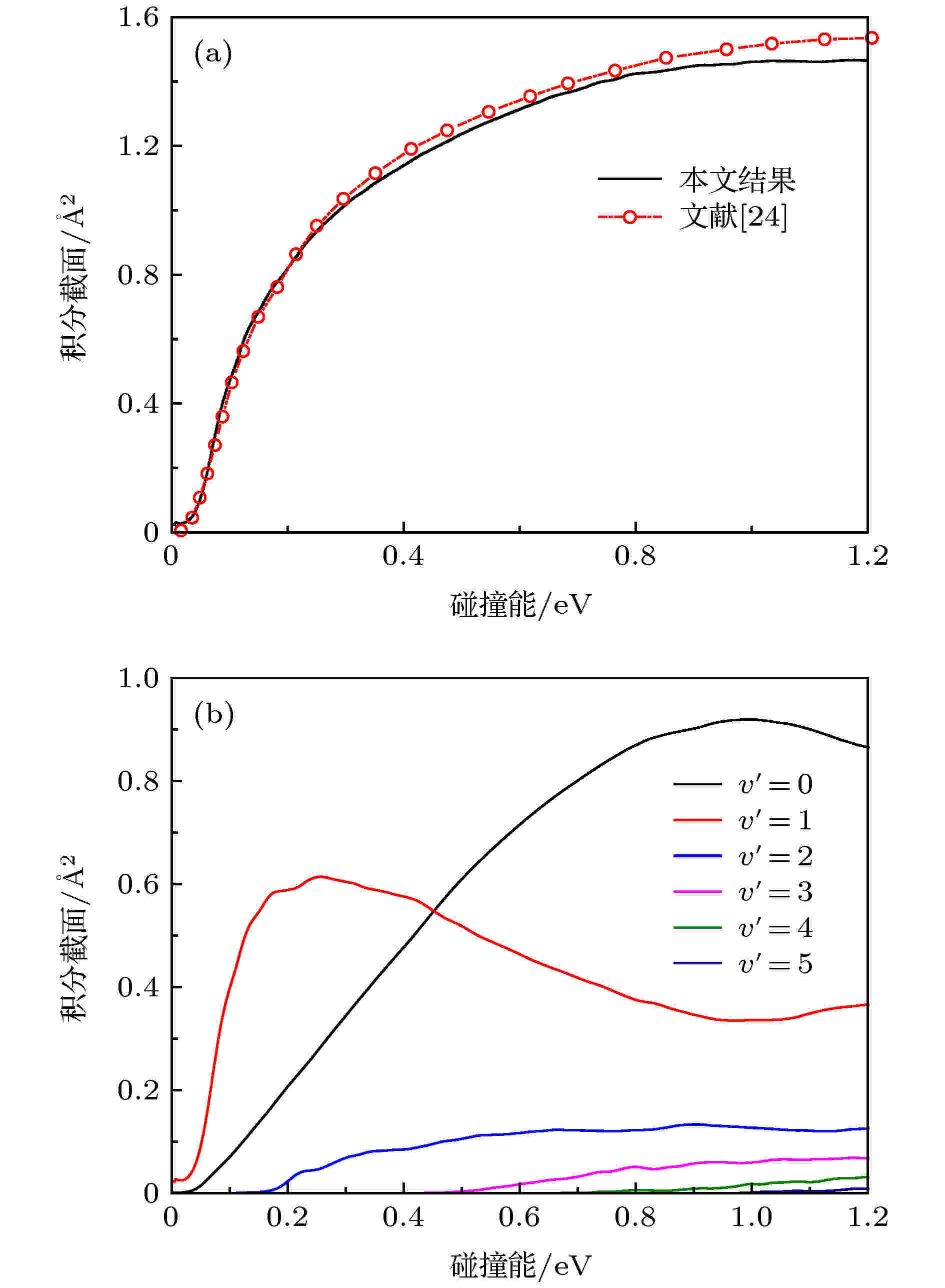 图 3 (a) 抽取反应总积分截面和文献[24]的结果比较; (b) 抽取反应振动分辨的积分截面
图 3 (a) 抽取反应总积分截面和文献[24]的结果比较; (b) 抽取反应振动分辨的积分截面Figure3. (a) Comparison between present total integral cross section of abstraction reaction and the values obtained from Ref. [24]; (b) the vibrational state-resolved integral cross section of abstraction reaction.
图4给出了抽取反应在碰撞能为0.4, 0.6, 0.8和1.0 eV时产物的振转态分布. 由图4可知, 随着碰撞能的升高, 振动电子态的数目和转动量子数的数目都增加. 这反映了随着碰撞能的升高会有更多的碰撞能转化为内能. 此外, 还可以看出越高的振动态具有越少的转动量子数, 这是因为当总能固定的情况下, 内部的转动能量转化为振动能量. 我们还发现随着碰撞能的升高, 出现了共振峰结构. 例如, 当0.4 eV时, v' = 1是单峰结构, 0.6 eV时变为双峰, 0.8 eV时变为三峰, 1.0 eV时变为多峰结构. 在图1, 抽取反应的最小能量路径上没有发现明显的势阱. 本文认为, 尽管最小能量路径上没有势阱, 然而当产物D2分子处于振动激发态的时候, 就会形成势阱, 并且随着振动态数目的变大形成的势阱也会变深, 相应的势阱支持的束缚态和准束缚态的寿命会变长并且不同电子态之间的波函数耦合也会变得强烈. 这也可以解释为什么1.0 eV时基态的共振峰的数目多于其他能量.
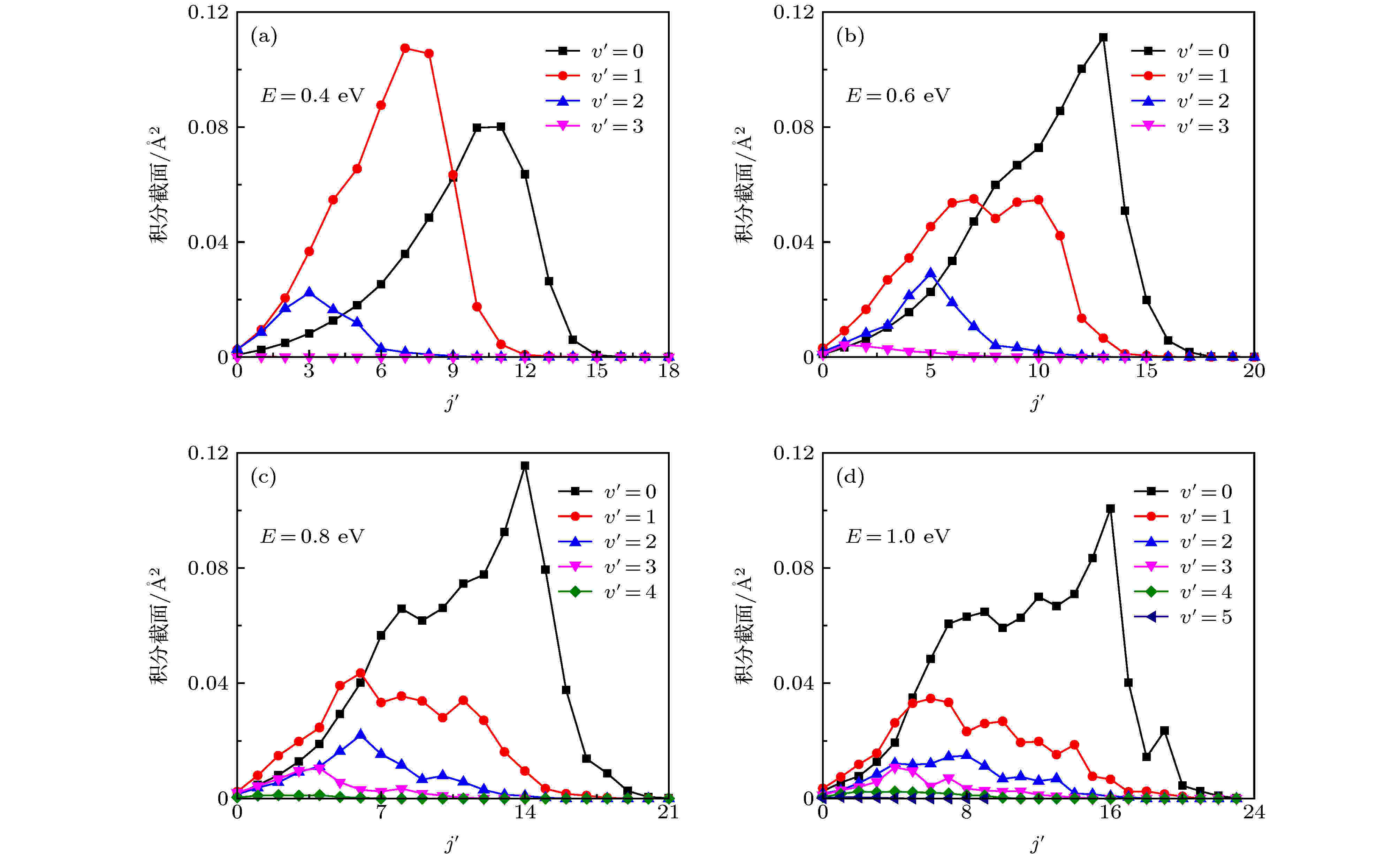 图 4 在若干选择的碰撞能下, 产物D2的振转态分布
图 4 在若干选择的碰撞能下, 产物D2的振转态分布Figure4. The ro-vibrational distribution of D2 at several selected collision energies.
图5给出置换反应的总积分截面和振动分辨的积分截面. 它们的形状与图2中的反应概率类似, 都是随着碰撞的增加单调递增. 并且随着碰撞的增加, 其他振动激发态的通道逐渐打开. 产物的振动态分布也是随着振动激发态的增加逐渐递减. 主要的振动态分布集中在基态和第一激发态上.
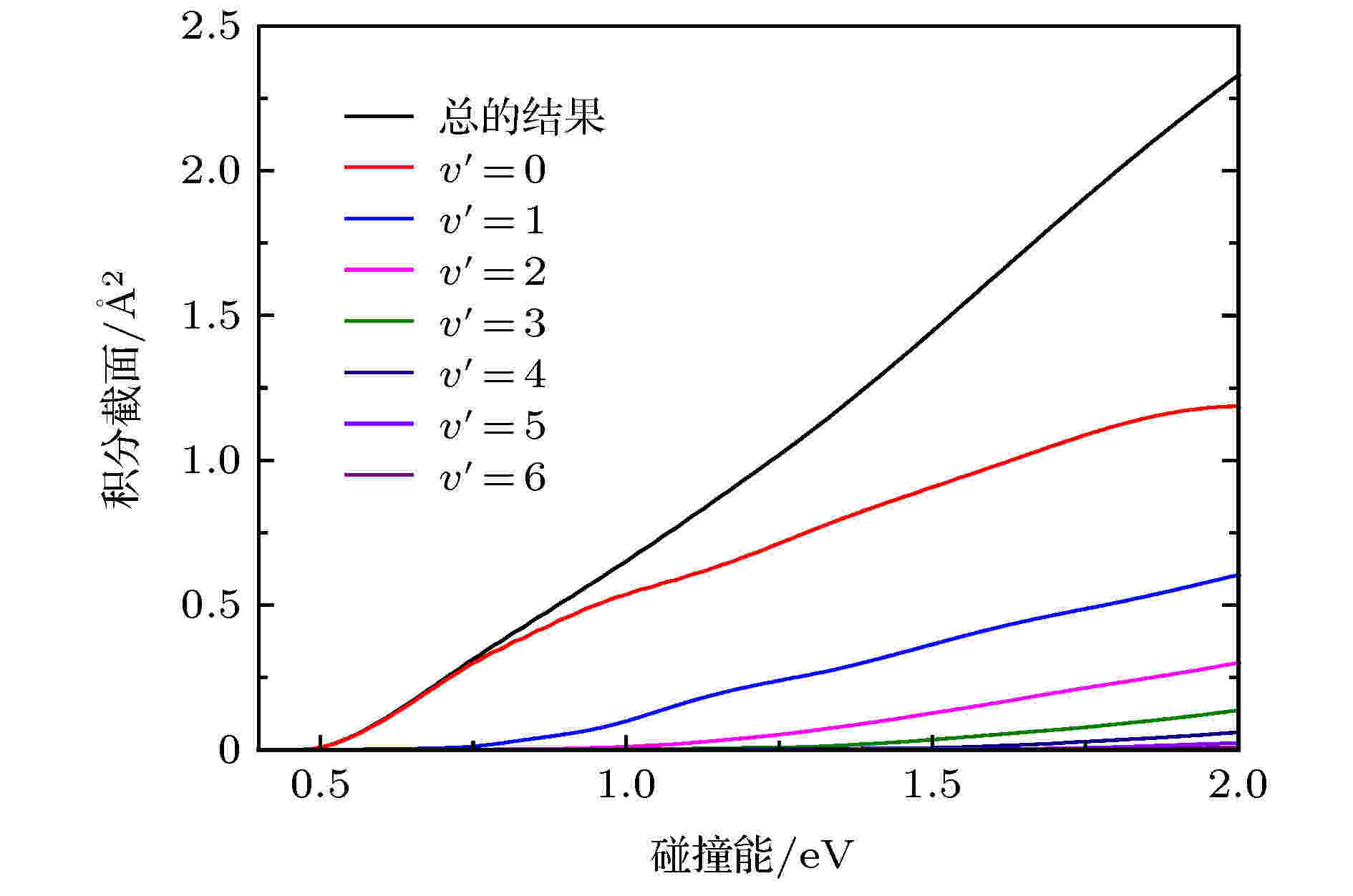 图 5 置换反应总的积分截面和振动分辨的积分截面
图 5 置换反应总的积分截面和振动分辨的积分截面Figure5. The total and vibrational state-resolved integral cross section of exchange reaction.
图6给出了置换反应在碰撞为0.8, 1.2, 1.6和2.0 eV时的产物分布. 与图4类似, 随着碰撞能的升高, 振动态的数目和转动量子数的数目都增加, 表明更多的碰撞能转化为内能. 在0.8和2.0 eV时的基态出现了有趣的双峰结构. 1.2和1.6 eV基态的峰偏向于较大转动量子数的位置.
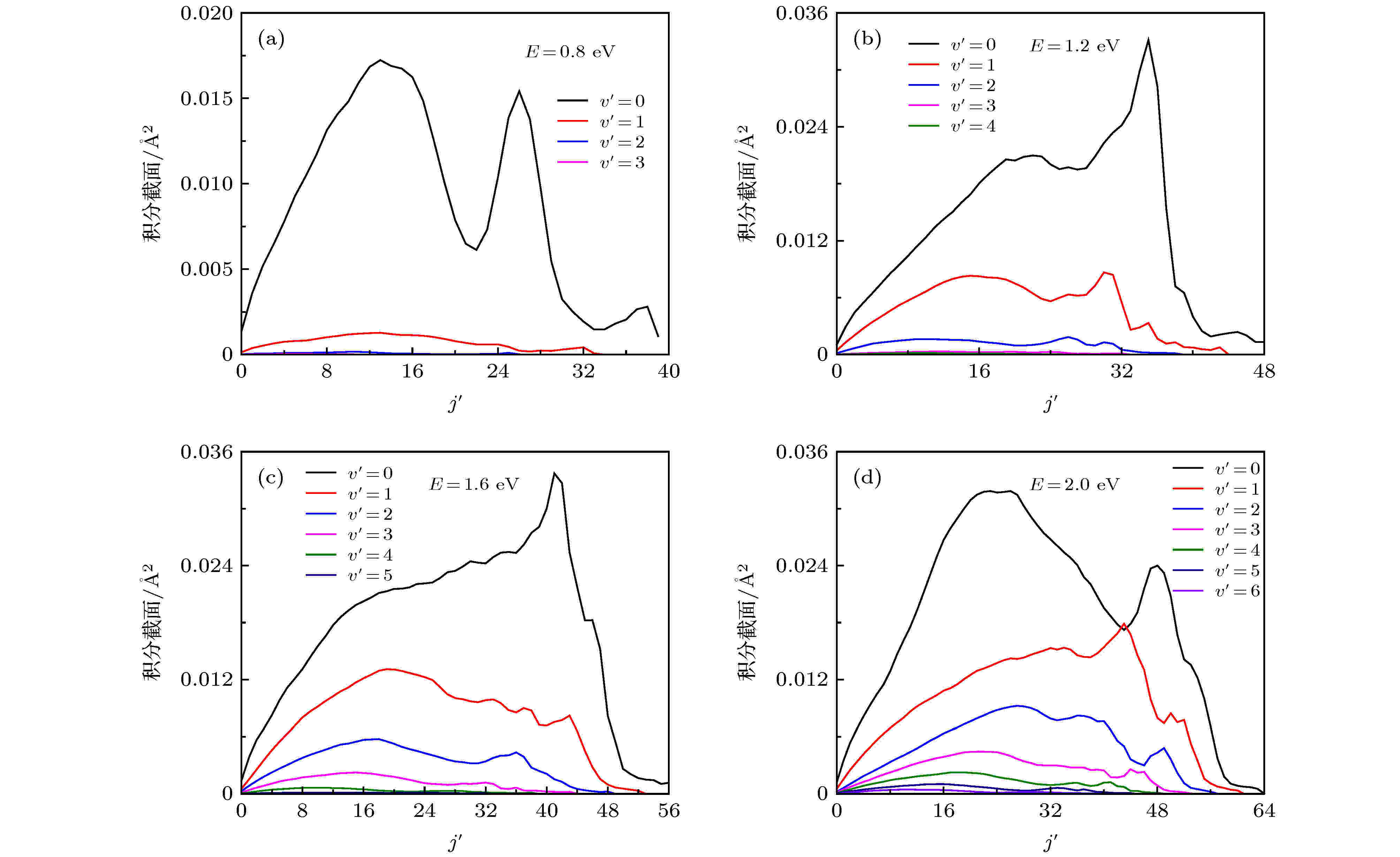 图 6 在若干选择的碰撞能下, 置换反应的产物的振转分布
图 6 在若干选择的碰撞能下, 置换反应的产物的振转分布Figure6. The ro-vibrational distribution of products for exchange reaction at several selected collision energies.
2
3.3.微分截面
图7给出了不同碰撞能下抽取反应和置换反应的微分截面. 对于抽取反应, 在低碰撞能时主要有后向和侧向散射信号, 这表明在低碰撞能时, 头碰头的反弹机制反应机制占据主导地位. 随着能量的升高, 后向散射变的不明显, 前向散射变得越加明显, 这表明反应机制由头碰头的反弹机制转变为剥离反应机制. 侧向的信号在Li等[25]的分析中是因为势能面上两个电子态交叉的势阱引起的, 是不可靠的. 对于置换反应, 在低碰撞能时, 散射信号主要集中在后向散射. 随着碰撞的增加, 后向散射信号变得明显, 同时侧向和前向的散射信号也变得明显. 不难看出对于置换反应, 反弹反应机制一直占据主导地位. 随着碰撞能的增加, D的速率变得越来越大, 使其带走质量相对较重的Br原子成为可能, 因此出现了侧向和前向的散射信号.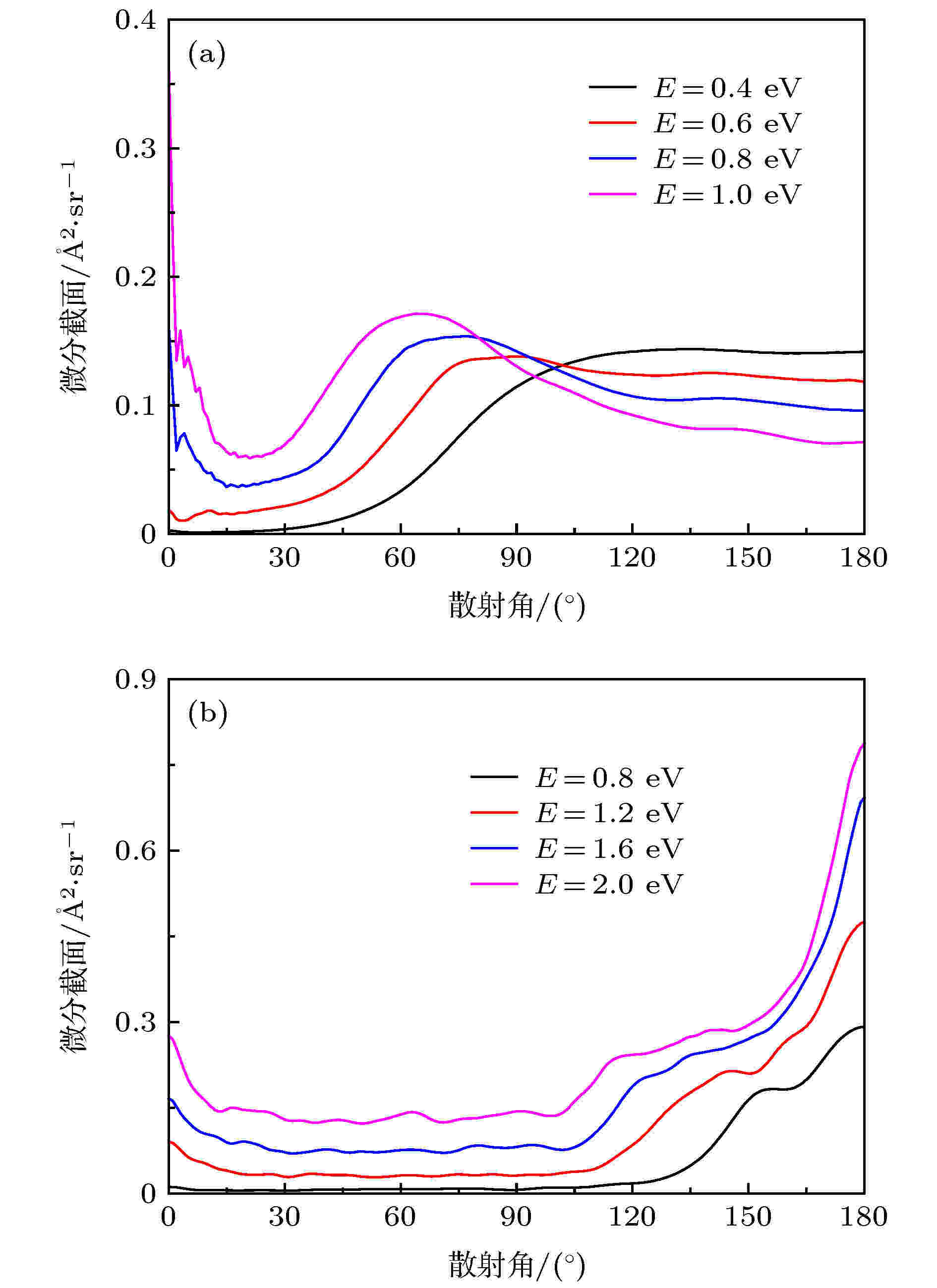 图 7 (a) 在若干碰撞能下, 抽取反应的微分截面; (b) 在若干碰撞能下, 置换反应的微分截面
图 7 (a) 在若干碰撞能下, 抽取反应的微分截面; (b) 在若干碰撞能下, 置换反应的微分截面Figure7. (a) The differential cross sections of abstraction reaction at several selected collision energies; (b) the differential cross sections of exchange reaction at several selected collision energies.
2
3.4.速率常数
抽取反应和置换反应在不同温度范围内的速率常数分别示于图8(a)和图8(b)中. 为了与相应的理论和实验结果比较, 文献[1,6,24]的结果也列入到了图8(a)中. 对于抽取反应, 速率常数随着温度的升高线性增加. 此外, 本文结果与Zhang等[24]的非绝热结果以及实验值都十分吻合. 尽管在低温时出现了一些微小的差距. 这可能是因为本文的结果是基于绝热的势能面, 另一方面与实验结果比较需要包含转动激发态的贡献, 而本文只考虑了基态的结果. 图8(b)给出了0—3000 K温度范围内置换反应的速率常数. 如图8(b)所示, 速率常数随着温度升高而增加.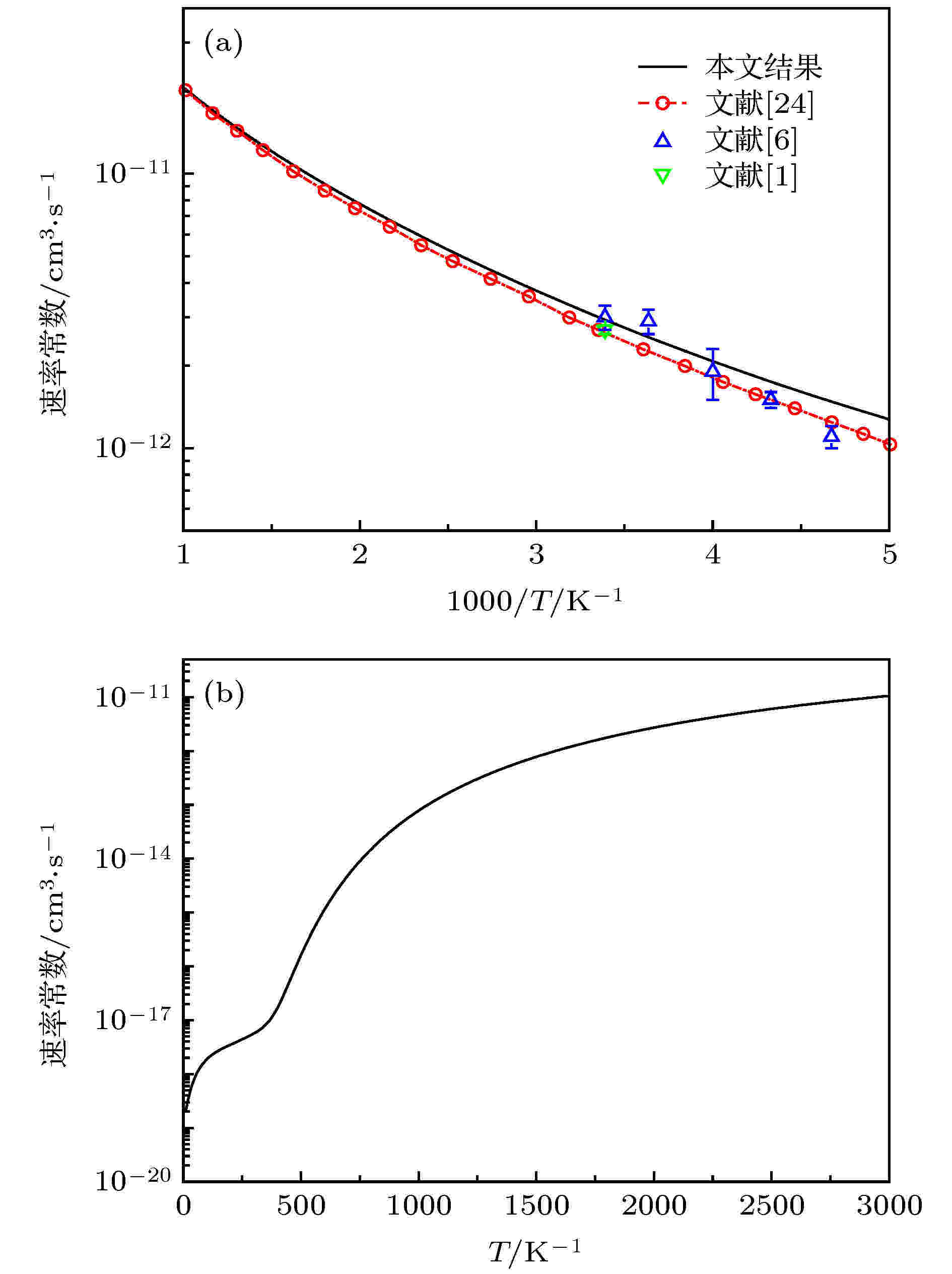 图 8 (a) 在200?1000 K温度范围内, 抽取反应的速率常数以及文献[1,6,24]的结果; (b) 在0?3000 K温度范围内, 置换反应的速率常数
图 8 (a) 在200?1000 K温度范围内, 抽取反应的速率常数以及文献[1,6,24]的结果; (b) 在0?3000 K温度范围内, 置换反应的速率常数Figure8. (a) The rate constant of abstraction reaction and the values obtained from Refs.[1,6,24] in the temperature range from 200 to 1000 K; (b) the rate constant of the exchange reaction in the temperature range from 0 to 3000 K.


